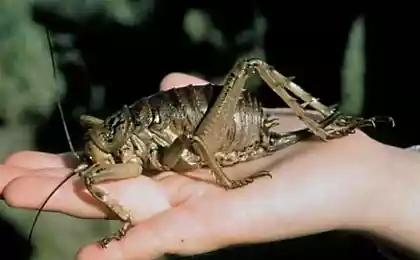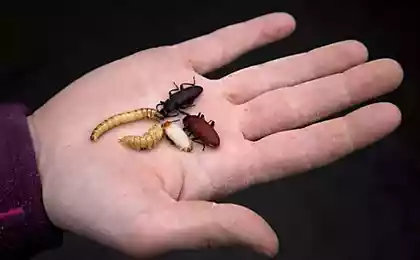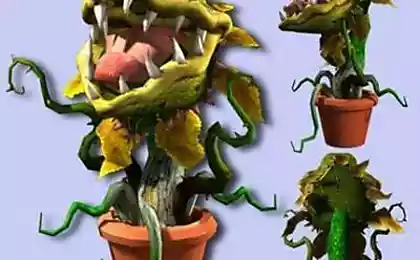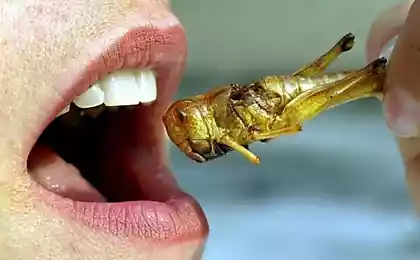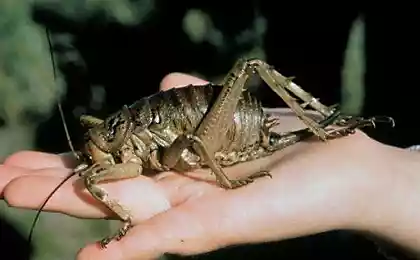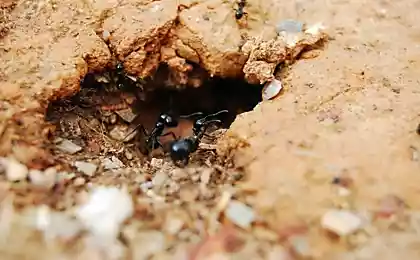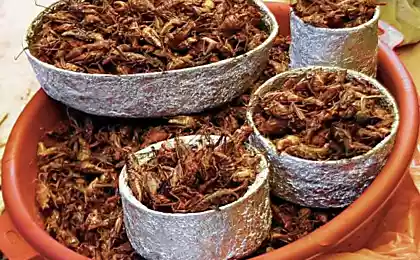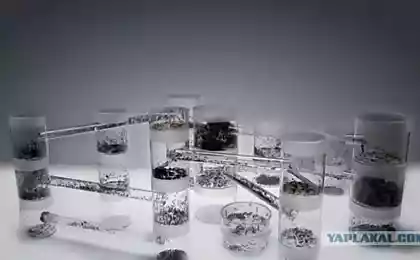1086
Superpowers insects
Many people are afraid of insects, probably because they are creepy, disgusting, strange and terrible. However, despite his strange appearance, some insects possess incredible abilities that are able to give a head start to other animals and even us humans. Despite their tiny size and simple brains, these lowly creatures play a key role in addressing one of the greatest problems of humanity.
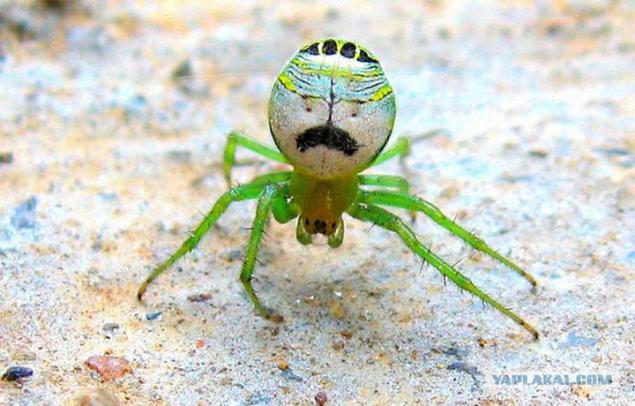
10. Cockroaches
Cockroaches are perhaps the most unloved creatures in the world. Despite this, they are also the most powerful. In itself, the presence of one cockroach in the house can make the strongest, the most imperious people jump, run and scream like a girl.
However, most people do not know that cockroaches have great value in the medical world. A number of researchers are now studying cockroaches for their ability to treat one of the deadliest human diseases. Scientists have discovered that the brains of cockroaches contain "nine antibiotic molecules ... that protect them from voracious, deadly bacteria." So what does this have to modern medicine? The fact that the antibacterial molecules in the brain cockroaches are more potent than the antibiotics that we use today. In fact, the antibacterial properties of these disgusting insects are much more effective than some of our modern medicines, they make "prescription drugs look like a sugar pill." Laboratory tests have shown that using antibacterial molecules in cockroaches can be easily cured methicillin-resistant Staphylococcus aureus - a bacterial infection, which is more deadly than AIDS, and E. coli.
In addition to their amazing healing powers, cockroaches also have an incredible ability to survive in nuclear explosions. When Hiroshima and Nagasaki were destroyed by atomic bombs, the only survivors were cockroaches. However, it is important to note that this amazing ability has its limitations. Under the influence of 100,000 units glad cockroaches still die.
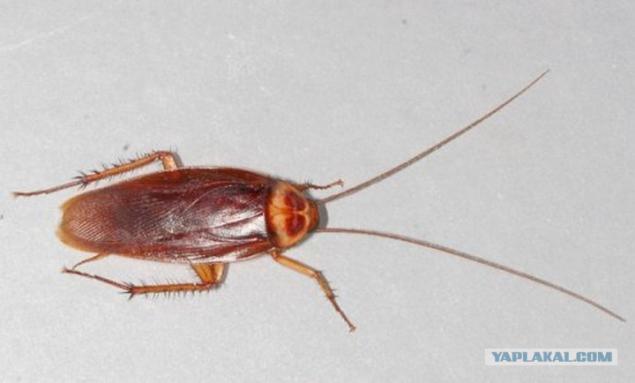
9. Bees.
Bees are among the most intelligent of insects in the animal world. Besides the fact that they have their own complex communications, they also possess extraordinary navigational skills, despite the fact that their vision is limited.
It is well known that honeybees can communicate with each other. They perform a series of movements called "wagging dance" to tell each other where there is food or what place is best suitable for the construction of a new colony. However, many people do not know that dance is very complicated and incredibly advanced for such tiny creatures. Honeybees know that the Earth is round, and they take this fact into account when they learn the location of a particular food source. In addition, they can also easily calculate angles, just by reading its data wagging dance. For example, if the direction of the bee dancing from 12 to 6 hours, this means that the food or a house situated directly from the sun. In contrast, the movement in the direction of from 6 to 12 hours means that the bees must be "fly straight to the sun." Movement in the direction of 7 to 1 hour means that the bees have to fly "to the right of the sun».
In addition to communicating with each other, honeybees are also guided in their environment through other means such as remembering visual cues, accounting position of the Sun, and the use of the electromagnetic field of the Earth.
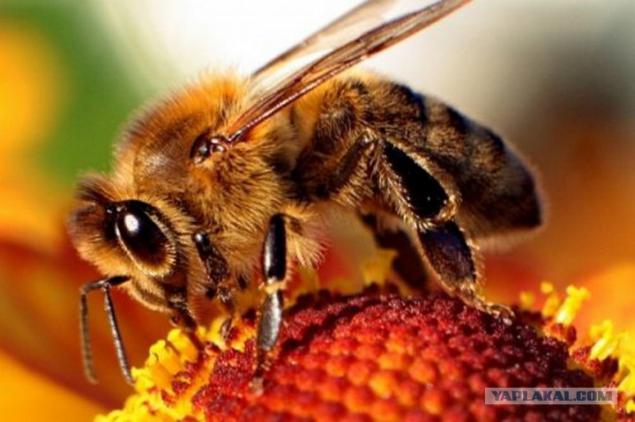
8. Locusts
Locust is one of the most effective drivers in the world of insects. These winged creatures, which many people feel threatened, can fly long distances without using too much energy. For many years, scientists have studied them, and know that even if these insects do not make frequent tremors and waving, they are able to maintain a steady pace of flight. Their ability to maintain a steady pace of flight does not change, even if the air temperature and winds are unfavorable. This amazing ability allows them to travel great distances, without spending a lot of energy.
Even more surprising is that the locust has the ability to turn their wings during flight. In doing so, they can maintain and even to control the number of strokes, which they do. This in turn helps in maintaining their flight at a constant velocity. This option allows them to fly up to 80 kilometers a day without the need to rest.
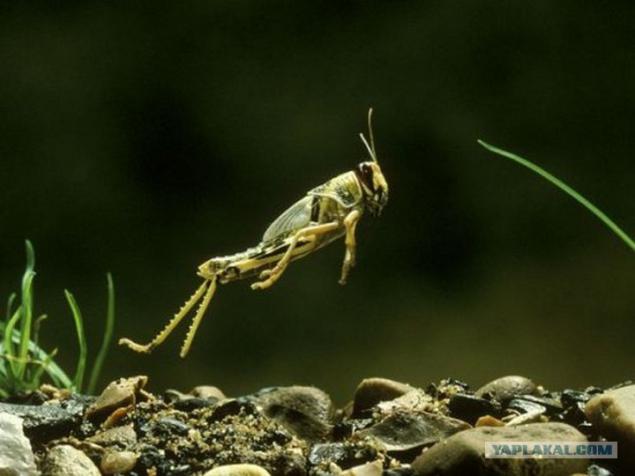
7. Fireflies.
The amazing ability of fireflies to produce their own light, is a miracle in the animal world and a source of inspiration and joy for many of us. As a child, you probably have experienced that magical feeling that occurs when a flickering twilight of these amazing creatures.
Another thing that we humans can learn from fireflies is how to efficiently use energy. Fireflies were designed by nature so that the use of energy, without losing most of it through the heat. Light bulbs, which are installed in our homes, using only 10 percent of its total energy to produce light. The remaining 90 percent are wasted thermal energy. On the other hand, the surprising body fireflies are arranged so that they can use 100 percent of the energy to generate light. If fireflies were like a light bulb that they would use only 10 per cent to generate light and the remaining 90 percent is allocated in the form of heat, they almost certainly would have burned to death.
In addition, just like the bees, fireflies can also communicate with each other. Fireflies use their ability to produce light to signal to each other that they are ready to mate. Males fireflies emit different types of flicker (each type has its own unique combinations) that signal the female fireflies that they are "idle". At the same time, if the female firefly interested in mating, it also responds by flicker.
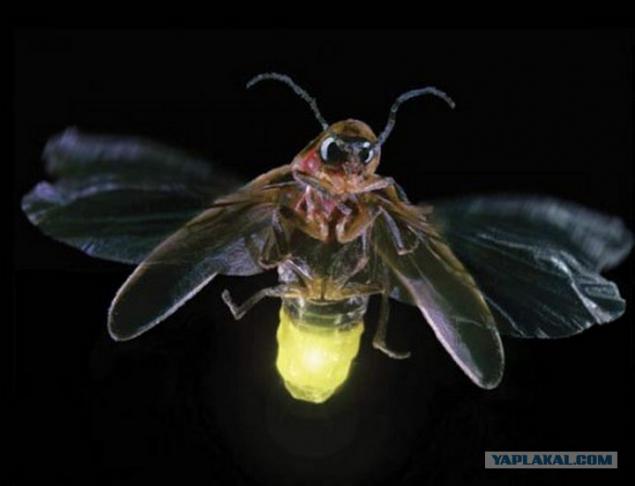
6. Fleas
Fleas are harmful not only for your pet but also for you and your family. Despite this, they have something that deserves admiration for the human: these insects are able to jump to a height greater than their own growth by 150 times! This may not seem very surprising, if you consider this possibility in terms of insects, but if you look at it in terms of person, you'll find that fleas chasing your pets really are incredible creatures.
Take the following example: the growth of a particular person, let's call it Basil, is 175 centimeters. If he was a flea, he could jump to 263 meters into the air, and he, therefore, could have been, in fact, to overcome gravity. Just imagine how different our world would be if we had this amazing ability to fleas. It would be fewer cars, less pollution, lower costs, etc. So next time, when you crush a flea, think about what she can do.
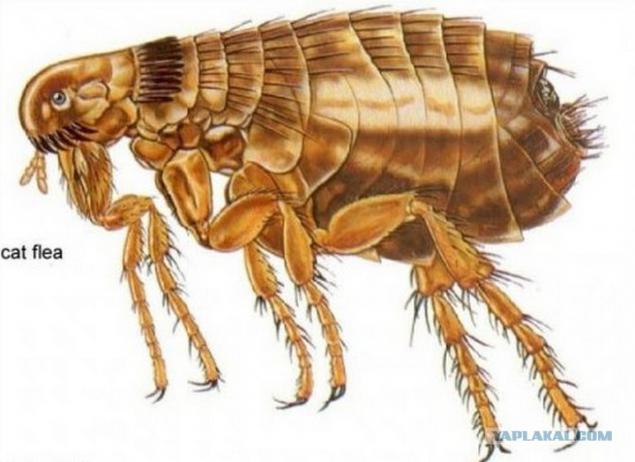
5. dung beetles.
There are two reasons why the dung beetles were included in this list: feces and astronomy. It may surprise you, but these two seemingly unrelated items were bound by these incredible creatures.
Dung beetles are very disgusting way of life. They collect animal droppings, rolled them into a ball, and use it for different purposes. They can use the ball as his home, to postpone eggs in it, or if they are hungry, they have a snack. However, what is surprising is that dung beetles have an incredible ability to roll their "balls of dung" in a straight line, even at night! Intrigued by this entertaining ability, Marie Dake (Marie Dacke), a biologist at the University of Lund (Lund University) in Sweden, conducted an experiment. She put the dung beetles in a planetarium and watched as insects can successfully roll a dung ball in a straight line with "all the starry sky».
To experiment more interesting, Dake decided to show only the Milky Way galaxy. Surprisingly, dung beetles still able to roll their precious dung balls in a straight line. Conclusion: The dung beetles are great processors and incredible astronomers.
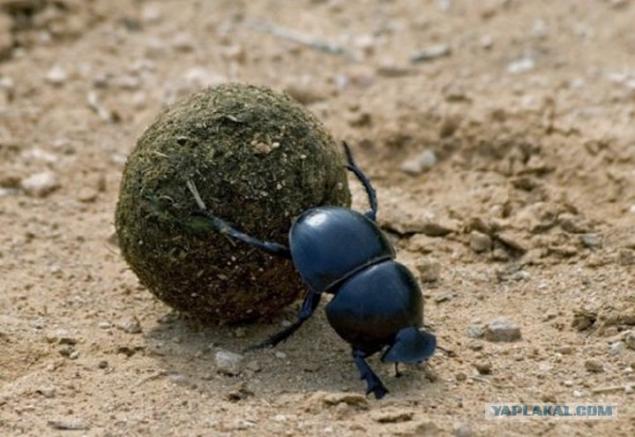
4. Dragonflies.
We humans have an amazing ability of selective attention. Right now, you use this ability to eliminate various distractions and focus on the reading and understanding of this list. For many years, scientists thought that only primates have this amazing ability. However, a new study has shown that a certain winged creature in the world of insects also has selective attention - dragonfly.
Dragonflies have a very small brain, and yet in the hunt, they rely on selective attention. If you see a dragonfly swarm of tiny insects, she focuses her attention on just one individual. Through selective attention, it eliminates other potential prey to swarm and focuses solely on your goals. Dragonflies are very accurate when it comes to catching their prey. Their likelihood of success is very high - 97 percent!

3. Ants.
Ants have an amazing ability to always find your way home, even if they wandered away from home in search of food. Scientists have long known that the ants use a variety of visual cues that remind them of where they have their colony. However, I wonder how ants manage to find their way home in some places, such as deserts, where there are no clear guidelines? This question is a simple experiment tried to answer Dr. Marcus Knaden (Markus Knaden), Dr. Catherine Stack (Kathrin Steck) and Professor Bill Hanson (Bill Hanson) from the Institute of Chemical Ecology Max Planck (Max-Planck Institute for Chemical Ecology) in Germany.
For their experiment, the scientists used the Tunisian desert ant. They placed four different odors around the entrance to the nest, and found that the entrance was barely visible. Giving ants enough time trying to associate odors with their home, they remove the smell, and then put them in a different location, with themselves, with no nest and no input. At the new place were only four smell, used earlier in the same place.
Surprisingly, the ants went to the place where the smells were located (in the same place where he was to be the entrance to the nest)! This experiment proved that the ants can smell in stereo, that is, they have the ability to simultaneously feel two different odors emanating from two unique directions. In addition, the experiment also proved that in places such as the desert, the ants do not rely on visual cues. They create a "map of smells" of its habitat, using his "stereo sense of smell." While there is the smell, they always find their way home.
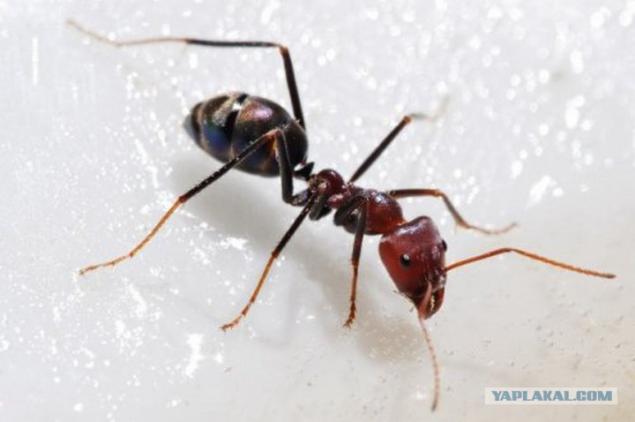
2. Wasps-riders.
Wasp-riders are so called because of their "magic" ability to convert their prey or enemies in a "zombie". It may sound like something from a science fiction movie, however, scientists have shown that the wasp-riders are really capable of inducing other insects in a condition similar to a zombie state. Even more scary is the fact that as soon as the insects become zombies, wasp-riders can control them.
Wasp-riders lay their eggs inside the bodies of young larvae of moths. The larvae survive in caterpillars feeding on the body fluids of the host. Once the larva is fully developed, they are chosen from the body of the caterpillar eaten her skin. Then they create a cocoon and are attached to the leaf or branch. But what it is a little bit scary, but not the least interesting part. Caterpillar vehicle wasp eggs rider does not leave the cocoon, rather than to deal with their own affairs, the caterpillar cocoon acts as a bodyguard, protecting it from a variety of predators.
The researchers conducted an experiment that showed that the infected caterpillars do become "zombie bodyguards" a-riders putting them face to face with beetles defenders. Caterpillars, which have not been infected, did nothing to stop the beetles defenders held near the cocoon. In contrast, caterpillars infected protected cocoon, knocking beetle from a branch. Scientists do not know why the infected caterpillars protected cocoon. Nevertheless, they learned that this incredible ability wasps riders plays a crucial role in their survival.
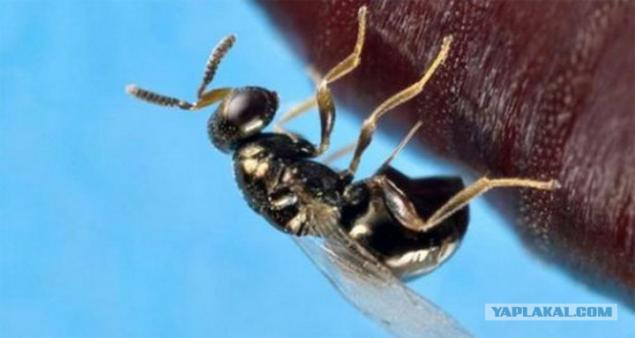
1. bombardier beetle.
When it comes to defensive strategies in the insect world, nothing beats the beetle scorer. This creature has an incredible ability to shoot a hot mixture of chemical solution is strong enough to injure his enemies. Toxic mixture sprayed bug, the temperature can reach an impressive 100 degrees Celsius.
But even more exciting is the complex structure of the body of the bombardier beetle. The fact that both chemicals, hydrogen peroxide and hydroquinone, which is an insect uses to injure their enemies dangerous and lead to death. If they did not keep and do not mix properly, these chemicals will lead to the fact that the bombardier beetle to explode! If not for their well-designed body, the bombardier beetles would not exist. At the end of the abdominal cavity of the insect has two glands. They separate the hydrogen peroxide with hydroquinone. If beetle scorer feels threatened its sphincter muscles squeeze the desired amount of chemicals in a certain part of the body where they are mixed together with other toxic substances. The result is a hot mixture of toxic chemicals that can injure enemies bombardier beetle.
That's all, thank you. Taken from here
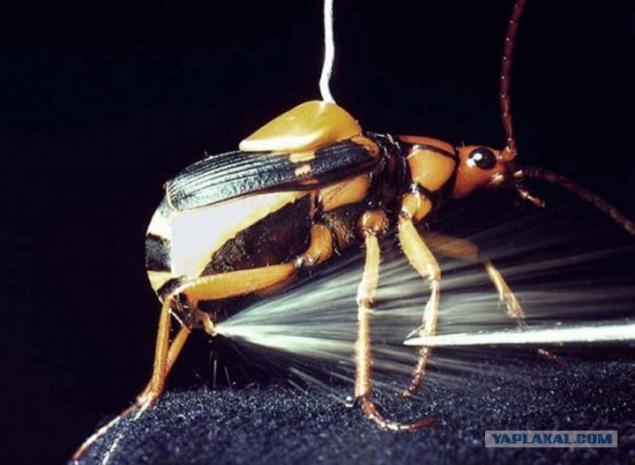

10. Cockroaches
Cockroaches are perhaps the most unloved creatures in the world. Despite this, they are also the most powerful. In itself, the presence of one cockroach in the house can make the strongest, the most imperious people jump, run and scream like a girl.
However, most people do not know that cockroaches have great value in the medical world. A number of researchers are now studying cockroaches for their ability to treat one of the deadliest human diseases. Scientists have discovered that the brains of cockroaches contain "nine antibiotic molecules ... that protect them from voracious, deadly bacteria." So what does this have to modern medicine? The fact that the antibacterial molecules in the brain cockroaches are more potent than the antibiotics that we use today. In fact, the antibacterial properties of these disgusting insects are much more effective than some of our modern medicines, they make "prescription drugs look like a sugar pill." Laboratory tests have shown that using antibacterial molecules in cockroaches can be easily cured methicillin-resistant Staphylococcus aureus - a bacterial infection, which is more deadly than AIDS, and E. coli.
In addition to their amazing healing powers, cockroaches also have an incredible ability to survive in nuclear explosions. When Hiroshima and Nagasaki were destroyed by atomic bombs, the only survivors were cockroaches. However, it is important to note that this amazing ability has its limitations. Under the influence of 100,000 units glad cockroaches still die.

9. Bees.
Bees are among the most intelligent of insects in the animal world. Besides the fact that they have their own complex communications, they also possess extraordinary navigational skills, despite the fact that their vision is limited.
It is well known that honeybees can communicate with each other. They perform a series of movements called "wagging dance" to tell each other where there is food or what place is best suitable for the construction of a new colony. However, many people do not know that dance is very complicated and incredibly advanced for such tiny creatures. Honeybees know that the Earth is round, and they take this fact into account when they learn the location of a particular food source. In addition, they can also easily calculate angles, just by reading its data wagging dance. For example, if the direction of the bee dancing from 12 to 6 hours, this means that the food or a house situated directly from the sun. In contrast, the movement in the direction of from 6 to 12 hours means that the bees must be "fly straight to the sun." Movement in the direction of 7 to 1 hour means that the bees have to fly "to the right of the sun».
In addition to communicating with each other, honeybees are also guided in their environment through other means such as remembering visual cues, accounting position of the Sun, and the use of the electromagnetic field of the Earth.

8. Locusts
Locust is one of the most effective drivers in the world of insects. These winged creatures, which many people feel threatened, can fly long distances without using too much energy. For many years, scientists have studied them, and know that even if these insects do not make frequent tremors and waving, they are able to maintain a steady pace of flight. Their ability to maintain a steady pace of flight does not change, even if the air temperature and winds are unfavorable. This amazing ability allows them to travel great distances, without spending a lot of energy.
Even more surprising is that the locust has the ability to turn their wings during flight. In doing so, they can maintain and even to control the number of strokes, which they do. This in turn helps in maintaining their flight at a constant velocity. This option allows them to fly up to 80 kilometers a day without the need to rest.

7. Fireflies.
The amazing ability of fireflies to produce their own light, is a miracle in the animal world and a source of inspiration and joy for many of us. As a child, you probably have experienced that magical feeling that occurs when a flickering twilight of these amazing creatures.
Another thing that we humans can learn from fireflies is how to efficiently use energy. Fireflies were designed by nature so that the use of energy, without losing most of it through the heat. Light bulbs, which are installed in our homes, using only 10 percent of its total energy to produce light. The remaining 90 percent are wasted thermal energy. On the other hand, the surprising body fireflies are arranged so that they can use 100 percent of the energy to generate light. If fireflies were like a light bulb that they would use only 10 per cent to generate light and the remaining 90 percent is allocated in the form of heat, they almost certainly would have burned to death.
In addition, just like the bees, fireflies can also communicate with each other. Fireflies use their ability to produce light to signal to each other that they are ready to mate. Males fireflies emit different types of flicker (each type has its own unique combinations) that signal the female fireflies that they are "idle". At the same time, if the female firefly interested in mating, it also responds by flicker.

6. Fleas
Fleas are harmful not only for your pet but also for you and your family. Despite this, they have something that deserves admiration for the human: these insects are able to jump to a height greater than their own growth by 150 times! This may not seem very surprising, if you consider this possibility in terms of insects, but if you look at it in terms of person, you'll find that fleas chasing your pets really are incredible creatures.
Take the following example: the growth of a particular person, let's call it Basil, is 175 centimeters. If he was a flea, he could jump to 263 meters into the air, and he, therefore, could have been, in fact, to overcome gravity. Just imagine how different our world would be if we had this amazing ability to fleas. It would be fewer cars, less pollution, lower costs, etc. So next time, when you crush a flea, think about what she can do.

5. dung beetles.
There are two reasons why the dung beetles were included in this list: feces and astronomy. It may surprise you, but these two seemingly unrelated items were bound by these incredible creatures.
Dung beetles are very disgusting way of life. They collect animal droppings, rolled them into a ball, and use it for different purposes. They can use the ball as his home, to postpone eggs in it, or if they are hungry, they have a snack. However, what is surprising is that dung beetles have an incredible ability to roll their "balls of dung" in a straight line, even at night! Intrigued by this entertaining ability, Marie Dake (Marie Dacke), a biologist at the University of Lund (Lund University) in Sweden, conducted an experiment. She put the dung beetles in a planetarium and watched as insects can successfully roll a dung ball in a straight line with "all the starry sky».
To experiment more interesting, Dake decided to show only the Milky Way galaxy. Surprisingly, dung beetles still able to roll their precious dung balls in a straight line. Conclusion: The dung beetles are great processors and incredible astronomers.

4. Dragonflies.
We humans have an amazing ability of selective attention. Right now, you use this ability to eliminate various distractions and focus on the reading and understanding of this list. For many years, scientists thought that only primates have this amazing ability. However, a new study has shown that a certain winged creature in the world of insects also has selective attention - dragonfly.
Dragonflies have a very small brain, and yet in the hunt, they rely on selective attention. If you see a dragonfly swarm of tiny insects, she focuses her attention on just one individual. Through selective attention, it eliminates other potential prey to swarm and focuses solely on your goals. Dragonflies are very accurate when it comes to catching their prey. Their likelihood of success is very high - 97 percent!

3. Ants.
Ants have an amazing ability to always find your way home, even if they wandered away from home in search of food. Scientists have long known that the ants use a variety of visual cues that remind them of where they have their colony. However, I wonder how ants manage to find their way home in some places, such as deserts, where there are no clear guidelines? This question is a simple experiment tried to answer Dr. Marcus Knaden (Markus Knaden), Dr. Catherine Stack (Kathrin Steck) and Professor Bill Hanson (Bill Hanson) from the Institute of Chemical Ecology Max Planck (Max-Planck Institute for Chemical Ecology) in Germany.
For their experiment, the scientists used the Tunisian desert ant. They placed four different odors around the entrance to the nest, and found that the entrance was barely visible. Giving ants enough time trying to associate odors with their home, they remove the smell, and then put them in a different location, with themselves, with no nest and no input. At the new place were only four smell, used earlier in the same place.
Surprisingly, the ants went to the place where the smells were located (in the same place where he was to be the entrance to the nest)! This experiment proved that the ants can smell in stereo, that is, they have the ability to simultaneously feel two different odors emanating from two unique directions. In addition, the experiment also proved that in places such as the desert, the ants do not rely on visual cues. They create a "map of smells" of its habitat, using his "stereo sense of smell." While there is the smell, they always find their way home.

2. Wasps-riders.
Wasp-riders are so called because of their "magic" ability to convert their prey or enemies in a "zombie". It may sound like something from a science fiction movie, however, scientists have shown that the wasp-riders are really capable of inducing other insects in a condition similar to a zombie state. Even more scary is the fact that as soon as the insects become zombies, wasp-riders can control them.
Wasp-riders lay their eggs inside the bodies of young larvae of moths. The larvae survive in caterpillars feeding on the body fluids of the host. Once the larva is fully developed, they are chosen from the body of the caterpillar eaten her skin. Then they create a cocoon and are attached to the leaf or branch. But what it is a little bit scary, but not the least interesting part. Caterpillar vehicle wasp eggs rider does not leave the cocoon, rather than to deal with their own affairs, the caterpillar cocoon acts as a bodyguard, protecting it from a variety of predators.
The researchers conducted an experiment that showed that the infected caterpillars do become "zombie bodyguards" a-riders putting them face to face with beetles defenders. Caterpillars, which have not been infected, did nothing to stop the beetles defenders held near the cocoon. In contrast, caterpillars infected protected cocoon, knocking beetle from a branch. Scientists do not know why the infected caterpillars protected cocoon. Nevertheless, they learned that this incredible ability wasps riders plays a crucial role in their survival.

1. bombardier beetle.
When it comes to defensive strategies in the insect world, nothing beats the beetle scorer. This creature has an incredible ability to shoot a hot mixture of chemical solution is strong enough to injure his enemies. Toxic mixture sprayed bug, the temperature can reach an impressive 100 degrees Celsius.
But even more exciting is the complex structure of the body of the bombardier beetle. The fact that both chemicals, hydrogen peroxide and hydroquinone, which is an insect uses to injure their enemies dangerous and lead to death. If they did not keep and do not mix properly, these chemicals will lead to the fact that the bombardier beetle to explode! If not for their well-designed body, the bombardier beetles would not exist. At the end of the abdominal cavity of the insect has two glands. They separate the hydrogen peroxide with hydroquinone. If beetle scorer feels threatened its sphincter muscles squeeze the desired amount of chemicals in a certain part of the body where they are mixed together with other toxic substances. The result is a hot mixture of toxic chemicals that can injure enemies bombardier beetle.
That's all, thank you. Taken from here





